9 Creative Case Study Presentation Examples & Templates
Learn from proven case study presentation examples and best practices how to get creative, stand out, engage your audience, excite action, and drive results.
9 minute read


helped business professionals at:

Short answer
What makes a good case study presentation?
A good case study presentation has an engaging story, a clear structure, real data, visual aids, client testimonials, and a strong call to action. It informs and inspires, making the audience believe they can achieve similar results.
Dull case studies can cost you clients.
A boring case study presentation doesn't just risk putting your audience to sleep—it can actuallyl ead to lost sales and missed opportunities.
When your case study fails to inspire, it's your bottom line that suffers.
Interactive elements are the secret sauce for successful case study presentations.
They not only increase reader engagement by 22% but also lead to a whopping 41% more decks being read fully , proving that the winning deck is not a monologue but a conversation that involves the reader.
Let me show you shape your case studies into compelling narratives that hook your audience and drive revenue.
Let’s go!
How to create a case study presentation that drives results?
Crafting a case study presentation that truly drives results is about more than just data—it's about storytelling, engagement, and leading your audience down the sales funnel.
Here's how you can do it:
Tell a story: Each case study should follow a narrative arc. Start with the problem, introduce your solution, and showcase the results. Make it compelling and relatable.
Leverage data: Hard numbers build credibility. Use them to highlight your successes and reinforce your points.
Use visuals: Images, infographics, and videos can enhance engagement, making complex information more digestible and memorable.
Add interactive elements: Make your presentation a two-way journey. Tools like tabs and live data calculators can increase time spent on your deck by 22% and the number of full reads by 41% .
Finish with a strong call-to-action: Every good story needs a conclusion. Encourage your audience to take the next step in their buyer journey with a clear, persuasive call-to-action.
Visual representation of what a case study presentation should do:
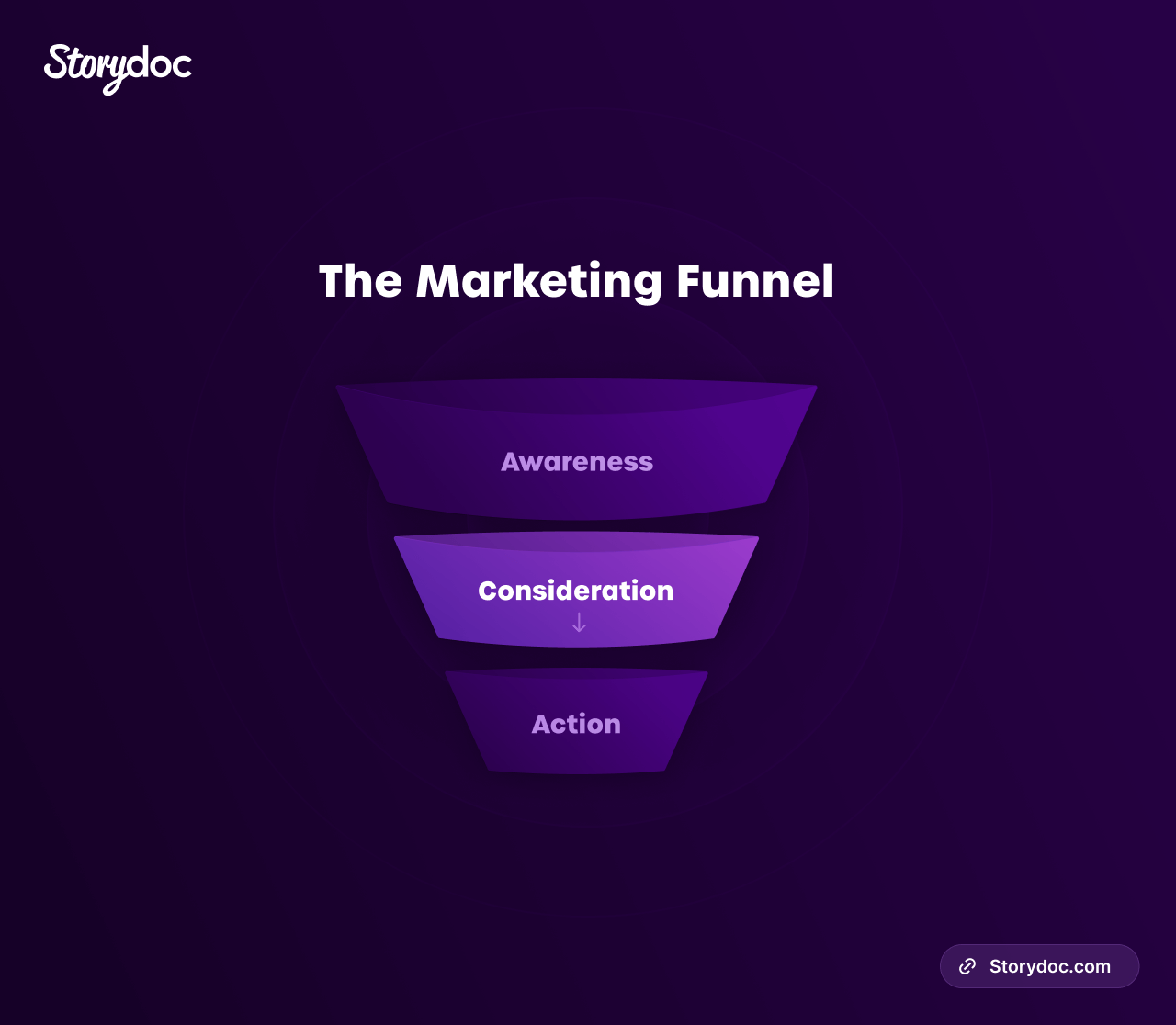
How to write an engaging case study presentation?
Creating an engaging case study presentation involves strategic storytelling, understanding your audience, and sparking action.
In this guide, I'll cover the essentials to help you write a compelling narrative that drives results.
What is the best format for a business case study presentation?
4 best format types for a business case study presentation:
- Problem-solution case study
- Before-and-after case study
- Success story case study
- Interview style case study
Each style has unique strengths, so pick one that aligns best with your story and audience. For a deeper dive into these formats, check out our detailed blog post on case study format types .

What to include in a case study presentation?
An effective case study presentation contains 7 key elements:
- Introduction
- Company overview
- The problem/challenge
- Your solution
- Customer quotes/testimonials
To learn more about what should go in each of these sections, check out our post on what is a case study .
How to motivate readers to take action?
Based on BJ Fogg's behavior model , successful motivation involves 3 components:
This is all about highlighting the benefits. Paint a vivid picture of the transformative results achieved using your solution.
Use compelling data and emotive testimonials to amplify the desire for similar outcomes, therefore boosting your audience's motivation.
This refers to making the desired action easy to perform. Show how straightforward it is to implement your solution.
Use clear language, break down complex ideas, and reinforce the message that success is not just possible, but also readily achievable with your offering.
This is your powerful call-to-action (CTA), the spark that nudges your audience to take the next step. Ensure your CTA is clear, direct, and tied into the compelling narrative you've built.
It should leave your audience with no doubt about what to do next and why they should do it.
Here’s how you can do it with Storydoc:

How to adapt your presentation for your specific audience?
Every audience is different, and a successful case study presentation speaks directly to its audience's needs, concerns, and desires.
Understanding your audience is crucial. This involves researching their pain points, their industry jargon, their ambitions, and their fears.
Then, tailor your presentation accordingly. Highlight how your solution addresses their specific problems. Use language and examples they're familiar with. Show them how your product or service can help them reach their goals.
A case study presentation that's tailor-made for its audience is not just a presentation—it's a conversation that resonates, engages, and convinces.
How to design a great case study presentation?
A powerful case study presentation is not only about the story you weave—it's about the visual journey you create.
Let's navigate through the design strategies that can transform your case study presentation into a gripping narrative.
Add interactive elements
Static design has long been the traditional route for case study presentations—linear, unchanging, a one-size-fits-all solution.
However, this has been a losing approach for a while now. Static content is killing engagement, but interactive design will bring it back to life.
It invites your audience into an evolving, immersive experience, transforming them from passive onlookers into active participants.
Which of these presentations would you prefer to read?

Use narrated content design (scrollytelling)
Scrollytelling combines the best of scrolling and storytelling. This innovative approach offers an interactive narrated journey controlled with a simple scroll.
It lets you break down complex content into manageable chunks and empowers your audience to control their reading pace.
To make this content experience available to everyone, our founder, Itai Amoza, collaborated with visualization scientist Prof. Steven Franconeri to incorporate scrollytelling into Storydoc.
This collaboration led to specialized storytelling slides that simplify content and enhance engagement (which you can find and use in Storydoc).
Here’s an example of Storydoc scrollytelling:

Bring your case study to life with multimedia
Multimedia brings a dynamic dimension to your presentation. Video testimonials lend authenticity and human connection. Podcast interviews add depth and diversity, while live graphs offer a visually captivating way to represent data.
Each media type contributes to a richer, more immersive narrative that keeps your audience engaged from beginning to end. You can upload your own interactive elements or check stock image sites like Shutterstock, Adobe Stock, iStock, and many more. For example, Icons8, one of the largest hubs for icons, illustrations, and photos, offers both static and animated options for almost all its graphics, whether you need profile icons to represent different user personas or data report illustrations to show your findings.
Prioritize mobile-friendly design
In an increasingly mobile world, design must adapt. Avoid traditional, non-responsive formats like PPT, PDF, and Word.
Opt for a mobile-optimized design that guarantees your presentation is always at its best, regardless of the device.
As a significant chunk of case studies are opened on mobile, this ensures wider accessibility and improved user experience , demonstrating respect for your audience's viewing preferences.
Here’s what a traditional static presentation looks like as opposed to a responsive deck:

Streamline the design process
Creating a case study presentation usually involves wrestling with an AI website builder .
It's a dance that often needs several partners - designers to make it look good, developers to make it work smoothly, and plenty of time to bring it all together.
Building, changing, and personalizing your case study can feel like you're climbing a mountain when all you need is to cross a hill.
By switching to Storydoc’s interactive case study creator , you won’t need a tech guru or a design whizz, just your own creativity.
You’ll be able to create a customized, interactive presentation for tailored use in sales prospecting or wherever you need it without the headache of mobilizing your entire team.
Storydoc will automatically adjust any change to your presentation layout, so you can’t break the design even if you tried.

Case study presentation examples that engage readers
Let’s take a deep dive into some standout case studies.
These examples go beyond just sharing information – they're all about captivating and inspiring readers. So, let’s jump in and uncover the secret behind what makes them so effective.
What makes this deck great:
- A video on the cover slide will cause 32% more people to interact with your case study .
- The running numbers slide allows you to present the key results your solution delivered in an easily digestible way.
- The ability to include 2 smart CTAs gives readers the choice between learning more about your solution and booking a meeting with you directly.
Light mode case study
- The ‘read more’ button is perfect if you want to present a longer case without overloading readers with walls of text.
- The timeline slide lets you present your solution in the form of a compelling narrative.
- A combination of text-based and visual slides allows you to add context to the main insights.
Marketing case study
- Tiered slides are perfect for presenting multiple features of your solution, particularly if they’re relevant to several use cases.
- Easily customizable slides allow you to personalize your case study to specific prospects’ needs and pain points.
- The ability to embed videos makes it possible to show your solution in action instead of trying to describe it purely with words.
UX case study
- Various data visualization components let you present hard data in a way that’s easier to understand and follow.
- The option to hide text under a 'Read more' button is great if you want to include research findings or present a longer case study.
- Content segmented using tabs , which is perfect if you want to describe different user research methodologies without overwhelming your audience.
Business case study
- Library of data visualization elements to choose from comes in handy for more data-heavy case studies.
- Ready-to-use graphics and images which can easily be replaced using our AI assistant or your own files.
- Information on the average reading time in the cover reduces bounce rate by 24% .
Modern case study
- Dynamic variables let you personalize your deck at scale in just a few clicks.
- Logo placeholder that can easily be replaced with your prospect's logo for an added personal touch.
- Several text placeholders that can be tweaked to perfection with the help of our AI assistant to truly drive your message home.
Real estate case study
- Plenty of image placeholders that can be easily edited in a couple of clicks to let you show photos of your most important listings.
- Data visualization components can be used to present real estate comps or the value of your listings for a specific time period, making it ideal for any real estate platform .
- Interactive slides guide your readers through a captivating storyline, which is key in a highly-visual industry like real estate .
Medical case study
- Image and video placeholders are perfect for presenting your solution without relying on complex medical terminology.
- The ability to hide text under an accordion allows you to include research or clinical trial findings without overwhelming prospects with too much information.
- Clean interactive design stands out in a sea of old-school medical case studies, making your deck more memorable for prospective clients.
Dark mode case study
- The timeline slide is ideal for guiding readers through an attention-grabbing storyline or explaining complex processes.
- Dynamic layout with multiple image and video placeholders that can be replaced in a few clicks to best reflect the nature of your business.
- Testimonial slides that can easily be customized with quotes by your past customers to legitimize your solution in the eyes of prospects.
Grab a case study presentation template
Creating an effective case study presentation is not just about gathering data and organizing it in a document. You need to weave a narrative, create an impact, and most importantly, engage your reader.
So, why start from zero when interactive case study templates can take you halfway up?
Instead of wrestling with words and designs, pick a template that best suits your needs, and watch your data transform into an engaging and inspiring story.

Hi, I'm Dominika, Content Specialist at Storydoc. As a creative professional with experience in fashion, I'm here to show you how to amplify your brand message through the power of storytelling and eye-catching visuals.
Found this post useful?
Subscribe to our monthly newsletter.
Get notified as more awesome content goes live.
(No spam, no ads, opt-out whenever)
You've just joined an elite group of people that make the top performing 1% of sales and marketing collateral.

Create your best pitch deck to date.
Stop losing opportunities to ineffective presentations. Your new amazing deck is one click away!

How to Write a Case Study in Research? (with Examples)

A case study is a powerful tool in research and education, offering deep insights into complex phenomena through the lens of a single subject or group. Case studies zoom in to the details of a specific situation, examining context, history, and behavior to reveal certain patterns and highlight practical applications of theories.
A case study in research can be used when:
- atypical or abnormal behavior or development is observed,
- an unexplained outcome to treatment is found, or
- an emerging disease or condition occurs.
Thus, case studies enable researchers and practitioners to analyze specific instances, identify trends, and obtain learnings that can inform broader decision-making and problem-solving. In this post, you will learn all about case studies, including how to conduct a case study , limitations and benefits of a case study , and case study methods .
What is a Case Study ?
Case study definition : A case study is an in-depth or intensive study of a person, group, or event. Case studies involve deep analyses of an individual or group to identify patterns and are used across fields such as psychology and medicine to draw broad conclusions. They are descriptive studies based on qualitative data such as observations, interviews, questionnaires, clinical notes.
Here are some historically significant case study examples:
The curious case of Phineas Gage: This is arguably the most cited case study in psychology, which sheds light on how different areas of the brain affect personality and cognition. While working as a construction foreman on a railroad, Phineas Gage was involved in an accident in which a rod impaled his brain. Gage survived the physical trauma, but his personality and his ability to learn new skills were altered. This case report was crucial to research on brain function, memory, and personality.
Anna O and the talking cure : Anna O (pseudonym) was a German woman who was one of the first patients to undergo psychoanalysis. Her case inspired many of the theories of Freud and other prominent psychologists of the time to mitigate the symptoms of depression through “talk therapy.” This case study is still cited as a reason psychologists believe that psychotherapy, or talk therapy, can be helpful to many patients.
When to Do a Case Study ?
The case study design may be chosen by a researcher in the following situations:
Need for deep understanding: When you require detailed insights about a specific situation, and you want to understand complex relationships and processes.
Resource constraints: When you have limited time and finances available for research and/or limited access to large sample sizes.
Research context: Certain real-world phenomena need to be studied in their natural context, especially when you cannot control variables.
Accordingly, the types of research questions best suited for a case study are exploratory (e.g., when investigating a new or poorly understood phenomenon, emerging conditions, adverse reactions to treatments, new methods of treatment) or involve unique situations (e.g., rare or exceptional cases, atypical behavior, breakthrough events). See Table 1 for developing a case study from a research question.
The case study design might be for a single case study, such as for unique cases or when studying a representative or typical case, or multiple case studies (a case series, comparative analysis, or to identify patterns across different contexts). Note that a case study is not recommended if you require statistical generalization or broad population-level insights.

How Long Should a Case Study Be?
Case studies are structured very differently from research articles (see “ How to write a case study in Research ” below and the case study template in Figure 1). However, as a general guideline, note that case studies might range from 500 to 1,500 words. The word count would depend on factors such as the target journal’s specifications, case type, and study discipline. Case reports also have a limit on the number of references to be cited. Remember, you must always check the target journal for word and reference limits before submission.
How to Write a Case Study in Research
Let’s delve into how to conduct a case study and write one. First, you need to understand how to create a case study .
Before writing
- On the basis of your research problem and research question , select the case that you want to study.
- Perform an in-depth literature review to develop a relevant theoretical framework, wherein you aim to demonstrate, expand upon, or challenge an existing theory in your field.
- Collect the data, which will typically be qualitative in nature. Data collection, therefore, will be collected by direct observations , interviews , or analysis of primary and secondary sources of information. Be as thorough as you can at this step.
- Analyze the case, highlighting key facts and problems, identify key problems and their causes and impacts, and explore potential solutions.
Drafting and writing your case study
The structure of the case report may vary—some follow the format of scientific papers, while others adopt a narrative style for a deeper exploration.
- State the key problem and present a concise thesis under an “Introduction” or “Background” section. Provide background, facts, and evidence of research.
- Describe the specific case, group, or event.
- 3. Provide specific solutions, suggest strategies for implementing the solution and, if needed, additional
- Discuss the case, including the strengths and limitations of the study. Summarize the outcome of your analysis and highlight specific strategies for implementing the proposed solution.
When describing and analyzing a case, be sure to include contextual details, link findings to existing literature and theory, and discuss broader implications. For medical case reports, follow the CARE guidelines (EQUATOR) to ensure completeness and transparency. Please also refer to the CARE Checklist of information to include when writing a case report. Finally, check the target journal requirements for word count and formatting guidelines. See Figure 1 for a case study template .

Figure 1. Case study template
Table 1. From research question to case study : Some fictional examples
Real case study examples (published):
- Baker et al. (2024) Enhanced family-based treatment for an adolescent with binge-eating disorder: A case report. Cognitive and Behavioral Practice . 31(2), 272–282.
- da Silva et al. (2024) Impacts of oil palm monocultures on freshwater ecosystems in the Amazon: a case study of dragonflies and damselflies (Insecta: Odonata). Aquatic Science 87, 1.
- Sakamoto et al. (2024) Online gaming reduces psychological distress in a patient with schizophrenia: A case report. PCN Reports. 3(3), e70015.

What Are the Benefits of a Case Study ?
On the topic of the case study , a quote by Ivy Mckenzie comes to mind: “The physician is concerned [unlike the naturalist]…with a single organism, the human subject, striving to preserve its identity in adverse circumstances .”
A physician’s meticulous documentation of an unusual or rare condition might not only help the patient but also revolutionize current understanding of the disorder and lead to a revision of treatment protocols. In fact, clinicians and psychologists are often encouraged to publish more case studies documenting the methods they use.
Let’s look at some more benefits of a case study :
- They can be published quickly.
- They are suitable under situations of time and budget crunches.
- They are appropriate to study phenomena in their natural context
- They allow detailed investigation into situations that would otherwise be impractical to perform using another study design.
- They are sometimes used in therapy to guide the best course of treatment.
What Are the Limitations of a Case Study ?
Case studies provide critical information and galvanize further research; however, there are some caveats. The following are the limitations of a case study :
- A case study is not definitive proof of a theory and cannot demonstrate cause and effect.
- Case studies with insufficient or incorrect information or based on a flawed premise can harm future research.
- Ethical issues may arise if the reported patients have not provided consent for publication of their case or are not treated with dignity and respect.
- If a patient declines to provide consent, the case report cannot be written or published.
- A case study cannot necessarily be generalized to the larger population.
- A case study might be impossible or difficult to replicate.
- Case reports can lead to bias.
Key Takeaways
- A case study in research is an in-depth or intensive study of a person, group, or event using qualitative data. It is used to examine complex phenomena through detailed analysis of specific instances. Case studies are particularly valuable in psychology, medicine, and other fields for drawing broader conclusions
- Case study methods involve data collection through direct observations, interviews, and analyses of primary and secondary sources.
- Case reports are typically 500–1,500 words long. You may develop single case studies (for unique cases) or multiple case studies (case series, for comparative analysis). Where applicable, be sure to follow specific guidelines (e.g., CARE guidelines for medical cases).
- A case study design is best used when deep understanding is needed, time and resources are limited, and the natural context must be preserved. It is suited to studying exploratory research questions, unique situations, emerging conditions, and atypical behavior.
- Writing case studies involves the following steps:
- Pre-writing phase:
– Select appropriate case based on research problem
– Conduct literature review
– Collect thorough qualitative data
– Analyze case to identify key problems
- Writing phase:
– State key problem and thesis in introduction
– Describe specific case/event
– Provide solutions and implementation strategies
– Discuss strengths and limitations
– Link findings to existing literature
- The advantages of case studies are that they permit quick writing and publication, are cost-effective, are suitable for natural context study, and are extremely valuable for rare or unusual cases. The limitations of case studies, however, are that they cannot prove cause and effect, may not be generalizable, are difficult to replicate, are prone to bias, and require patient consent in medical cases.

Frequently Asked Questions
What is a case study in research, why are case studies important in research, what are the key components of a case study, what is the difference between case studies and case series.
Paperpal is a comprehensive AI writing toolkit that helps students and researchers achieve 2x the writing in half the time. It leverages 22+ years of STM experience and insights from millions of research articles to provide in-depth academic writing, language editing, and submission readiness support to help you write better, faster.
Get accurate academic translations, rewriting support, grammar checks, vocabulary suggestions, and generative AI assistance that delivers human precision at machine speed. Try for free or upgrade to Paperpal Prime starting at US$25 a month to access premium features, including consistency, plagiarism, and 30+ submission readiness checks to help you succeed.
Experience the future of academic writing – Sign up to Paperpal and start writing for free!
Related Reads:
- PhD Qualifying Exam: Tips For Success
- Academic Editing: How to Self-Edit Academic Text With Paperpal
- How to Write the First Draft of a Research Paper with Paperpal?
How to Write an Academic Paragraph (Step-by-Step Guide)
Boost your earnings with paperpal’s newly launched affiliate program, you may also like, how to cite in apa format (7th edition):..., how to write your research paper in apa..., how to choose a dissertation topic, how to write a phd research proposal, research funding basics: what should a grant proposal..., how to write the first draft of a..., mla works cited page: format, template & examples, academic editing: how to self-edit academic text with..., measuring academic success: definition & strategies for excellence.
How to Write a Case Study: Bookmarkable Guide & Template
Updated: July 18, 2024
Published: June 13, 2012
Earning the trust of prospective customers can be a major challenge. Before you can expect to earn their business, you’ll need to demonstrate your ability to deliver on the promises of your product or service. The best way to win new business is with cold, hard proof.

A great way to prove your worth is through a compelling case study. HubSpot’s 2024 State of Marketing report found that case studies are so captivating that they were the fifth most commonly used type of content that marketers relied on.
That statistic still holds true in Forbes Advisor’s 2024 study, which adds that 78% of B2B businesses report using case studies and customer stories because they are “ crucial for demonstrating real-world value. ”
Having written these ever more frequently over the past ten years, I hope to serve as your guide through a process that can feel daunting, but I promise is worth the effort. Below, I'll walk you through what a case study is, how to prepare for writing one, what to include in it, and how it can be an effective tactic.
Table of Contents
Case Study Definition
- Why Write a Case Study?
- How Long Should a Case Study Be?
Case Study Templates
How to write a case study, case study format, business case study examples.
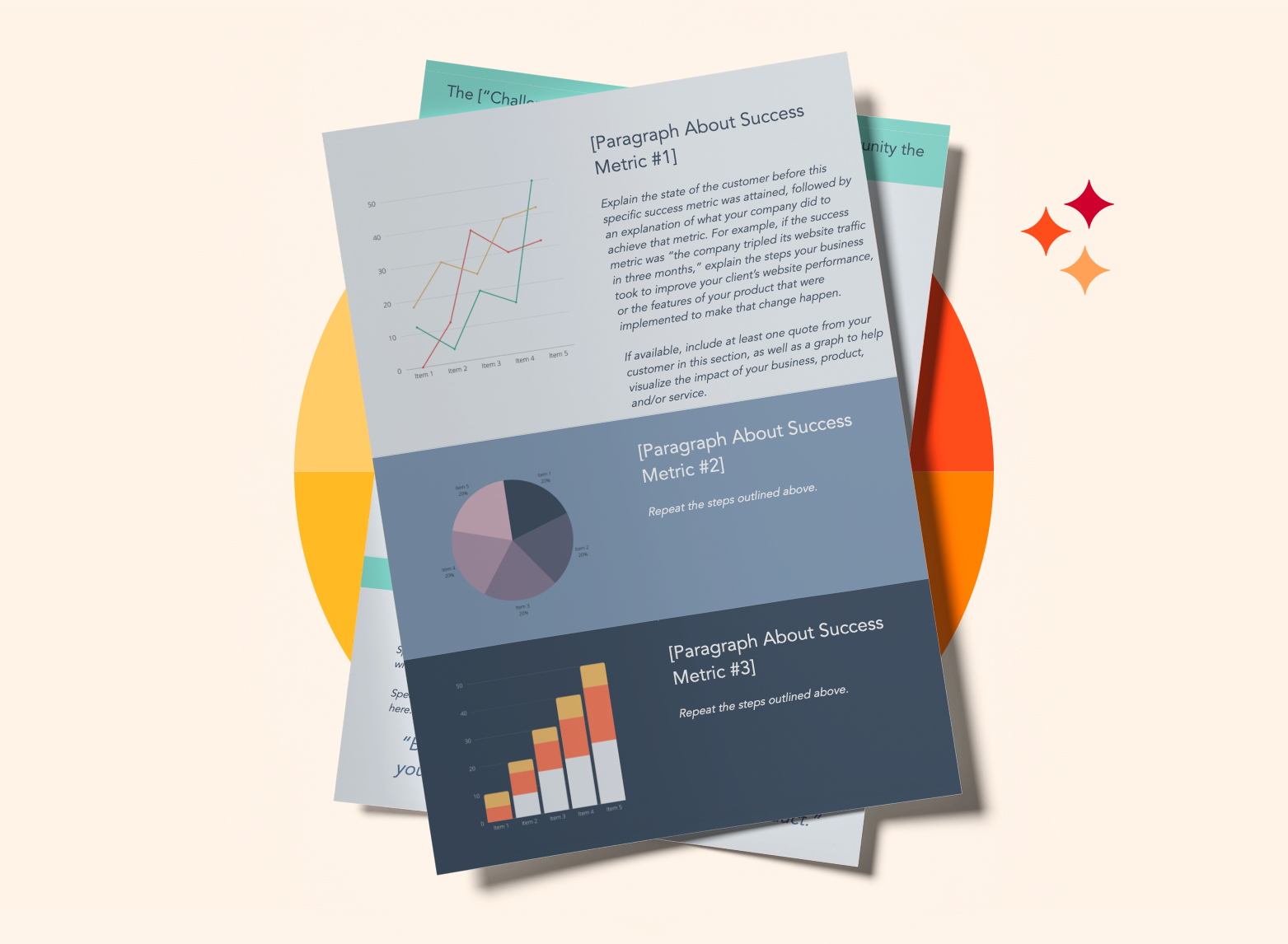
Free Case Study Templates
Showcase your company's success using these three free case study templates.
- Data-Driven Case Study Template
- Product-Specific Case Study Template
- General Case Study Template
Download Free
All fields are required.
You're all set!
Click this link to access this resource at any time.
A case study is coverage of a specific challenge a business has faced, and the solution they've chosen to solve it. Case studies can vary greatly in length and focus on several details related to the initial challenge and applied solution, and can be presented in various forms like a video, white paper, blog post, etc.
In professional settings, it‘s common for a case study to tell the story of a successful business partnership between a vendor and a client.
Perhaps the success you’re highlighting is in the number of leads your client generated, customers closed, or revenue gained. Any one of these key performance indicators (KPIs) are examples of your company's services in action.
When done correctly, these examples of your work can chronicle the positive impact your business has on existing or previous customers, helping you attract new clients.
Why write a case study?
I know, it sounds like a huge endeavor — is it really worth it?
The truth is that while case studies are a huge undertaking, they are powerful marketing tools that allow you to demonstrate the value of your product to potential customers using real-world examples.
Here are a few reasons why you should write case studies.
1. Explain complex topics or concepts.
Case studies give you the space to break down complex concepts, ideas, and strategies, showing how they can be applied in a practical way.
You can use real-world examples, like an existing client, and use their story to create a compelling narrative that demonstrates how your product solved their issue. Most importantly, it explains how those strategies can be repeated to help other customers get similar, successful results.
2. Show expertise.
Case studies are a great way to demonstrate your knowledge and expertise on a given topic or industry. This is where you get the opportunity to show off your problem-solving skills and how you’ve generated successful outcomes for clients you’ve worked with.
3. Build trust and credibility.
In addition to showing off the attributes above, case studies are an excellent way to build credibility. They’re often filled with data and thoroughly researched, which shows readers you’ve done your homework.
A robust case study instills confidence in the solutions you present because the reader has now vicariously experienced the problem — and they followed, step-by-step, what it took to solve it. These elements work together, enabling you to build trust with potential customers.
4. Create social proof.
Using existing clients that have seen success working with your brand builds social proof .
People are more likely to choose your brand if they know that others have found success working with you. Case studies do just that — put your success on display for potential customers to see.
All of these attributes play together like an orchestra to help you gain more clients. Afterward, the case study acts as a reference. You can pull quotes from customers that were featured in these studies to repurpose them in other marketing content.
How long should a case study be?
Now that you’re more acquainted with the benefits of producing a case study, let’s explore how long these documents should be.
The length of a case study will vary depending on the complexity of the project or topic discussed. However, as a general guideline, case studies typically range from 500 to 1,500 words.
Whatever length you choose, it should provide a clear understanding of the challenge, the solution you implemented, and the results achieved.
This may be easier said than done, but it‘s important to strike a balance between providing enough detail to make the case study informative and concise enough to keep the reader’s interest.
The primary goal here is to effectively communicate the key points and takeaways of the case study. It’s worth noting that this shouldn’t be a wall of text. Make it attractive to dive into by using headings, subheadings, bullet points, charts, and other graphics to break up the content and make it more scannable for readers.
I’ve also seen more and more brands incorporate video elements into case studies listed on their site for a more engaging experience, which is highly recommended given that video is currently the best performing marketing content format.


Benefits to Offer Your Case Study Candidate
Here are four potential benefits you can promise your case study candidate to gain their approval.
Product Discount
This is a more tangible incentive you can offer your case study candidate, especially if they're a current customer of yours.
If they agree to be your subject, offer them a product discount — or a free trial of another product — as a thank you for their help creating your case study.
The bigger the scope and size of the study, the more you can make the case to your finance department to justify larger gifts and get more buy-in.
Brand Exposure
Explain to your subject how and to whom this case study will be exposed.
This exposure can help increase their own brand awareness both in and beyond their own industry.
In the B2B sector, brand awareness can be hard to collect outside one‘s own market, making case studies particularly useful to a client looking to expand their name’s reach.
Employee Exposure
Allow your subject to provide quotes with credits back to specific employees.
When this is an option for them, their brand isn't the only thing expanding its reach — their employees can get their name out there, too.
This presents your subject with networking and career development opportunities they might not have otherwise.
Backlinks and Website Traffic
Backlinks are a benefit sure to resonate with your subject‘s marketing team. When you publish your case study on your website, make sure that your study links back to your subject’s website. This is known as a “backlink.”
If your reader clicks the link in your case study, it takes your reader to the subject's website. Essentially, this small gesture gives them additional website traffic from visitors who have read your case study.
Additionally, a backlink from you increases your subject's page authority in the eyes of Google, which is growing in difficulty as AI infiltrates the internet.
This helps them rank more highly in search engine results. Landing higher on the SERP enables them to collect more traffic from searchers who are looking for information about your subject’s industry.
Once you know what you’re going to offer your candidate, go ahead and contact them to see if they are interested in featuring in a customer success story, with the promise of more details to follow.
6. Ensure you have all the resources you need to proceed before you get a response.
Now it’s time to prepare the resources needed for if — when! — they agree to participate. At the very least, you’ll need a case study release form and a success story letter.
Let's break those two down.
Case Study Release Form
This document can vary, depending on factors like the size of your business, the nature of your work, and what you intend to do with the case study once it is completed.
You’ll need permission to use any brand names and to share the project information publicly.
You should typically aim to include the following in your Case Study Release Form:
- A clear explanation of why you are creating this case study and how it will be used.
- A statement defining the information and potentially trademarked information you expect to be able to include about the company — things like names, logos, job titles, and pictures.
- An explanation of what you would expect from the participant beyond the completion of the case study. For example, is this customer willing to act as a reference or share feedback? Do you have permission to pass contact information along for these purposes?
- A note about compensation.
Success Story Letter
This document serves as an outline for the entire case study process so your subject better understands the entire process they would be opting into.
You'll want to be sure to define the details outlined in your Case Study Release Form within your Success Story Letter. There are many details you’ll need to think about so that you can clearly explain what the process will be like.
7. Define the process you want to follow with the client.
Before you can begin the case study, you have to have a clear outline of the case study process with your client. An example of an effective outline would include the following information.
The Acceptance
First, you‘ll need to receive internal approval from the company’s marketing team.
Once approved, the Release Form should be signed and returned to you. It's also a good time to determine a timeline that meets the needs and capabilities of both teams.
The Questionnaire
To ensure that you have a productive interview — which is one of the best ways to collect information for the case study — you'll want to ask the participant to complete a questionnaire before this conversation.
That will provide your team with the necessary foundation to organize the interview, and get the most out of it.
The Interview
Once the questionnaire is completed, someone on your team should reach out to the participant to schedule a 30- to 60-minute interview.
This should include a series of custom questions related to the customer's experience with your product or service.
The Draft Review
After the case study is composed, you'll want to send a draft to the customer, allowing an opportunity to give you feedback and edits.
The Final Approval
Once any necessary edits are completed, send a revised copy of the case study to the customer for final approval.
Once the case study goes live — on your website or elsewhere — it‘s best to contact the customer with a link to the page where the case study lives.
Don’t be afraid to ask your participants to share these links with their own networks, as it not only demonstrates your ability to deliver positive results and impressive growth, as well.
8. Download a case study email template.
You’ve gathered your resources, and soon your candidate will get to explore the exciting details of participating in your case study.
The case study release form communicates what you'll need from your chosen subject, and your success story letter outlines the process in its entirety.
Hopefully by now they’ve replied that they are interested in working with you on a customer success story. It’s time to send your case study email!
To give you an idea of what that might look like, check out this sample email.
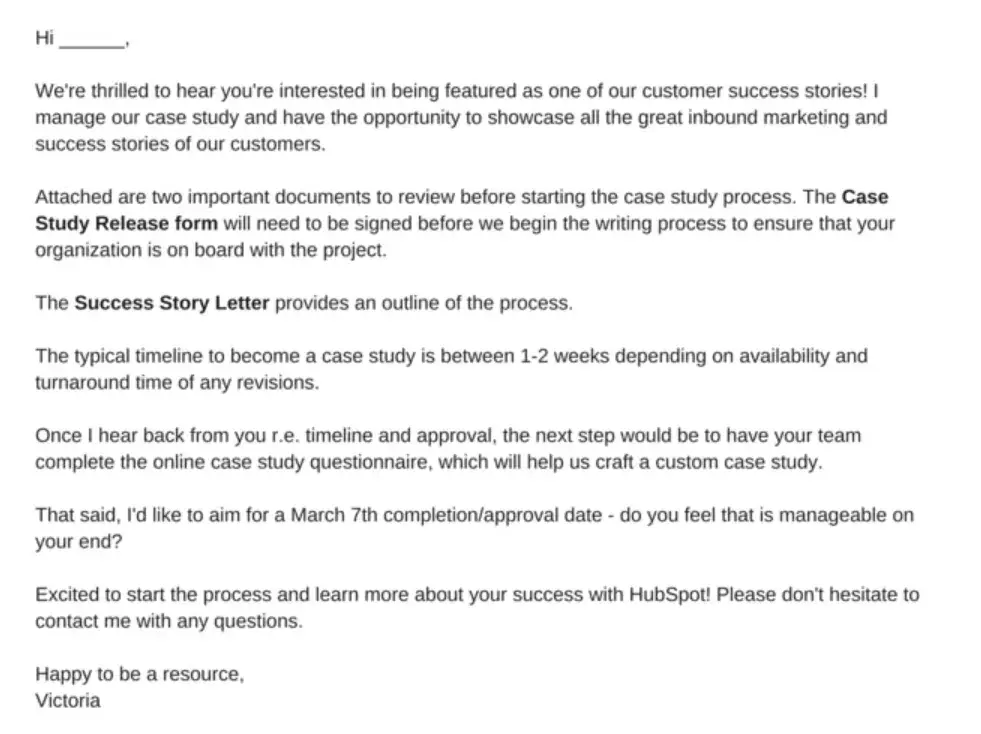
In terms of the interview structure, I recommend categorizing the questions in a way that the answers flow into six specific sections that will mirror a successful case study format. Combined, they'll allow you to gather enough information to put together a rich, comprehensive study.
Open with the customer's business.
The goal of this section is to generate a better understanding of the company's current challenges and goals, plus how they fit into the landscape of their industry. Sample questions might include:
- How long have you been in business?
- How many employees do you have?
- What are some of the objectives of your department at this time?
Cite a problem or pain point.
To tell a compelling story, you need context that helps match the customer's needs with your solution. Sample questions might include:
- What challenges and objectives led you to look for a solution?
- What might have happened if you did not identify a solution?
- Did you explore other solutions before this that did not work out? If so, what happened?
Discuss the decision process.
Exploring how the customer decided to work with you helps to guide potential customers through their own decision-making processes.
Sample questions might include:
- How did you hear about our product or service?
- Who was involved in the selection process?
- What was most important to you when evaluating your options?
Explain how a solution was implemented.
The focus here should be placed on the customer's experience during the onboarding process. Sample questions might include:
- How long did it take to get up and running?
- Did that meet your expectations?
- Who was involved in the process?
Explain how the solution works.
The goal of this section is to better understand how the customer is using your product or service. Sample questions might include:
- Is there a particular aspect of the product or service that you rely on most?
- Who is using the product or service?
End with the results.
In this section, you want to uncover impressive measurable outcomes — the more numbers, the better. Sample questions might include:
- How is the product or service helping you save time and increase productivity?
- In what ways does that enhance your competitive advantage?
- How much have you increased metrics X, Y, and Z?
It’s a smart idea to send a copy of your interview questions to your subject ahead of time so they can prepare strong answers and collect the numerical data you need from them.
10. Lay out your case study format.
When it comes time to take all of the information you‘ve collected and actually turn it into something useful, it’s easy to feel overwhelmed. I always do, but I also know that it works out in the end, so I just jump on in and work it through.
So where should you start? What should you include? What's the best way to structure it?
It‘s important to first understand that there is no one-size-fits-all when it comes to the ways you can present a case study.
They can be very visual, which you’ll see in some of the examples we've included below, and can sometimes be communicated through video or photos with a bit of accompanying text.
Here are the sections I’d suggest, and I'll cover these in more detail after #11 below:
- Title. Keep it short. Develop a succinct but interesting project name you can give the work you did with your subject.
- Subtitle. Use this copy to briefly elaborate on the accomplishment. What was done? The case study itself will explain how you got there.
- Executive Summary . A 2-4 sentence summary of the entire story. You'll want to follow it with 2-3 bullet points that display metrics showcasing success.
- About the Subject. An introduction to the person or company you served, which can be pulled from a LinkedIn Business profile or client website.
- Challenges and Objectives. A 2-3 paragraph description of the customer's challenges, before using your product or service. This section should also include the goals or objectives the customer set out to achieve.
- How Product/Service Helped. A 2-3 paragraph section that describes how your product or service provided a solution to their problem.
- Results. A 2-3 paragraph testimonial that proves how your product or service specifically benefited the person or company and helped achieve its goals. Include numbers to quantify your contributions.
- Supporting Visuals or Quotes. Pick one or two powerful quotes that you would feature at the bottom of the sections above, as well as a visual that supports the story you are telling.
- Future Plans. Everyone likes an epilogue. Comment on what's ahead for your case study subject, whether or not those plans involve you.
- Call-to-Action (CTA). Not every case study needs a CTA, but putting a passive one at the end of your case study can encourage your readers to take an action on your website after learning about the work you've done.
When laying out your case study, focus on conveying the information you've gathered in the most clear and concise way possible.
Make it easy to scan and comprehend, and be sure to provide an attractive call-to-action at the bottom — that should provide readers an opportunity to learn more about your product or service.
11. Publish and promote your case study.
Once you‘ve completed your case study, it’s time to publish and promote it.
Some case study formats have pretty obvious promotional outlets — a video case study can go on YouTube, just as an infographic case study can go on Pinterest.
But there are still other ways to publish and promote your case study. Here are a couple of ideas.
Lead Gen in a Blog Post
As stated earlier, written case studies make terrific lead-generators if you convert them into a downloadable format, like a PDF.
To generate leads from your case study, consider writing a blog post that tells an abbreviated story of your client‘s success and asking readers to fill out a form with their name and email address if they’d like to read the rest in your PDF.
Then, promote this blog post on social media, through a Facebook post or a tweet.
Published as a Page on Your Website
As a growing business, you might need to display your case study out in the open to gain the trust of your target audience.
Rather than gating it behind a landing page, publish your case study to its own page on your website, and direct people to it from your homepage with a “Case Studies” or “Testimonials” button along your homepage's top navigation bar.
The traditional case study format includes the following parts: a title and subtitle, a client profile, a summary of the customer’s challenges and objectives, an account of how your solution helped, and a description of the results. You might also want to include supporting visuals and quotes, future plans, and calls-to-action.

27 Case Study Examples Every Marketer Should See
![story based case study 7 Pieces of Content Your Audience Really Wants to See [New Data]](https://knowledge.hubspot.com/hubfs/contenttypes.webp)
7 Pieces of Content Your Audience Really Wants to See [New Data]

How to Market an Ebook: 21 Ways to Promote Your Content Offers
![story based case study How to Write a Listicle [+ Examples and Ideas]](https://www.hubspot.com/hubfs/listicle-1.jpg)
How to Write a Listicle [+ Examples and Ideas]
![story based case study What Is a White Paper? [FAQs]](https://53.fs1.hubspotusercontent-na1.net/hubfs/53/business%20whitepaper.jpg)
What Is a White Paper? [FAQs]

What is an Advertorial? 8 Examples to Help You Write One
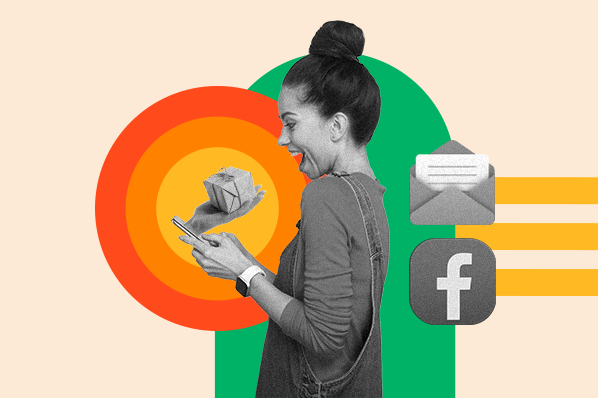
How to Create Marketing Offers That Don't Fall Flat
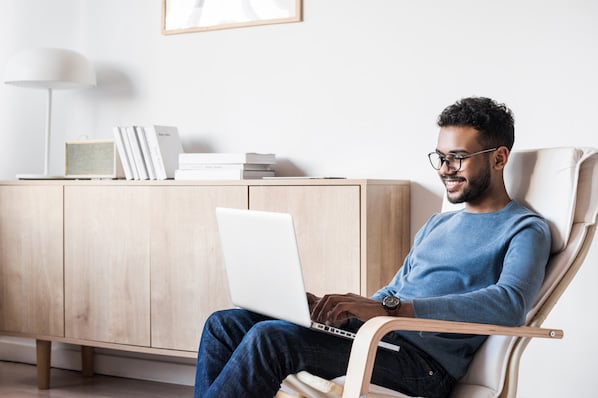
20 Creative Ways To Repurpose Content
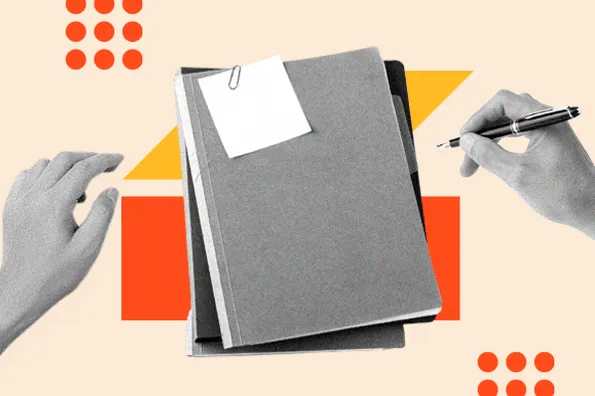
16 Important Ways to Use Case Studies in Your Marketing

11 Ways to Make Your Blog Post Interactive
Showcase your company's success using these free case study templates.
Marketing software that helps you drive revenue, save time and resources, and measure and optimize your investments — all on one easy-to-use platform
Filter by Keywords
10 Case Study Examples to Inspire Your Marketing Efforts
Sudarshan Somanathan
Head of Content
June 20, 2024
Start using ClickUp today
- Manage all your work in one place
- Collaborate with your team
- Use ClickUp for FREE—forever
When your prospects are nearing a decision in their buyer’s journey, a strong case study can sway them your way. After all, everyone, even corporate decision-makers, loves a good story.
That’s why having satisfied customers showcase your strengths is more impactful than any self-promotion. It boosts credibility and earns you valuable recognition when potential customers come across these case studies.
No matter what you offer, case studies work because they build trust. They showcase real-life success stories , their detailed analysis proving your expertise and the quality of your products or services.
That’s why they’re crucial for organizational growth.
Intrigued? Read on to explore the different types of case studies, their practical applications, and some marketing case study examples.
By the end of this blog post, you will also have learned how to write a case study using a case study template. ✍️
Understanding Case Studies
1. illustrative case studies, 2. exploratory case studies, 3. descriptive case studies, 4. cumulative case studies, 5. critical instance case studies, 6. instrumental case studies, 1. lucanet and hubspot, 2. cartoon network and clickup , 3. callingly and zapier , 4. philips and github , 5. google ads and samsung, 6. movingwaldo and mailchimp, 7. shutterstock and workday, 8. pidilite and salesforce , 9. sentinelone and storylane , 10. benchling and airtable , stage 1: research and preparation, stage 2: producing the case study, use the clickup case study template.
A case study is a detailed study of how your product or service has helped past customers.
It acts as a track record of your company’s association with past customers and an insight into how they benefitted from your product offerings.
You can think of case studies as story-telling based on real-world data and results.
Potential customers trust them because of their attention to detail in describing exactly how you delivered results for past customers. And if the past customer is someone they know or identify with, acquiring their trust is far easier.
According to the Content Marketing Institute, 73% of marketers use case studies , as they are proven tactics to drive sales.
These studies are tailored to various industries, from business and marketing to psychology, technology, and healthcare.
Creating compelling business case studies requires precision and clarity, like drafting a professional document. That’s where creative brief templates come in handy. They provide a structured framework to outline key details and create case study examples that resonate with your target audience.
Types of Case Studies
Knowing the distinct kinds of case studies will help you use the best combination to influence your potential customers. We’ll also cover a few case study examples later on so you can see the different ways in which you or your marketing team can create your own case studies.
While one type of case study may help customers solve a business problem through a product/solution, others may be more suited for studying a specific event or business phenomenon.
Let’s explore the commonly used types and case study examples.
Illustrative case studies describe a particular situation, phenomenon, or event. They use two or more instances to show just what a situation is like . The aim is to provide context, make the unfamiliar more accessible, and provide a real-world context for abstract concepts or theories.
For instance, SaaS case study examples highlight how a software solution significantly improved a client’s sales and efficiency.
Lids, a leading sports apparel retailer, has experienced rapid growth in recent years. To manage this growth effectively, Lids implemented ClickUp , a project management platform, to expedite workflows, save time, streamline administration, and improve results.
With ClickUp, our teams are more collaborative, efficient and we’re all more on-top of our work. It has made the way we work so much better.
The case study demonstrates how integrating a robust project management platform like ClickUp can streamline operations, enhance efficiency, and support substantial organizational growth.
Exploratory case studies are conducted before a large-scale investigation to help pinpoint research questions and methods for a more extensive study.
These are often used when there is limited prior knowledge or existing theories about the subject. They are more frequently employed in social science disciplines.
For example, a research case study investigates the link between mental health disorders and social media usage in younger populations.
Researchers conducted a systematic review focusing on the impact of social media use on mental health . The study aimed to provide insights for future mental health strategies by analyzing the relationship between social media use and mental health outcomes.
Utilizing research plan templates can help structure such investigations, ensuring an in-depth analysis and data collection and analysis efficiency.
A descriptive case study starts with a descriptive theory as a foundation. It then attempts to find connections between the subject of discussion and the theory. These case studies rely on detailed qualitative data analysis to develop an argument.
Let’s consider a descriptive case study example on the usage of technology in classrooms focused on an elementary school in a suburban district during the 2011-2012 academic year.
This compelling case study highlights the importance of detailed, qualitative data in developing its argument.
A cumulative case study collects information from various sources to summarize past studies without increasing costs or time. It aims to aggregate data from multiple sources to draw broader conclusions.
For example, a case study on the impact of climate change on the Indian coastline aggregates data from various sources to provide a comprehensive summary of past research.
It highlights that climate change and climate variability pose significant challenges to this ecosystem.
Critical instance case studies focus on a unique or critical event to learn more about its causes and consequences. They are often used to investigate rare or significant events.
For instance, Blackboard utilized Amazon EC2 Spot Instances to scale its virtual classroom solution amidst the COVID-19 pandemic.
This case study demonstrates how Blackboard effectively managed a staggering 4,800% surge in video conferencing usage while optimizing costs and enhancing performance.
Instrumental case studies use a specific case to generate insights into a broader issue or to refine a theoretical explanation. They are more frequently used to explore complex concepts or theories.
The story of Accenture’s Global SAP System serves as an instrumental case study example.
It uses Accenture’s journey to create a unified SAP system to generate strategic insights into broader issues related to aligning business and IT strategies, standardizing business processes, and establishing global governance structures.
10 Case Study Examples for Different Use Cases
Exploring a variety of case study examples can help you understand the nuances of their formatting, data presentation, and brand positioning. Here are ten case study examples to inspire you.

LucaNet is an international finance company that provides performance management solutions. With a global customer base, it wanted to opt for automated, personalized marketing in addition to handling complex lead management.
HubSpot helped LucaNet automate its global marketing operations and bring all customer data into a centralized hub.
What do we like best about this case study presentation? HubSpot immediately showcases its key achievements at the top and provides compelling data on time savings, lead generation, and increase in MQLs.
✔️Takeaway : Highlight your measurable impact to showcase your ability to deliver tangible outcomes.

Cartoon Network’s social media team struggled with managing complicated workflows across different project management tools.
ClickUp provided them with a unified platform to execute their social media management needs and ensure all team members are on the same page.
ClickUp’s case study of Cartoon Network is a good example of the appropriate use of supporting visuals. Rather than simply stating that ClickUp’s flexible views improved Cartoon Network’s project management, it demonstrates them in practical use.
✔️Takeaway : Create separate sections highlighting your client’s problem and the benefits offered by your solution in bullet points. The usage of supporting visuals is a major plus.

Callingly noticed that Zapier customers tend to get more value from their platform. To capitalize on this, they wanted to educate their customers on how to use Zapier effectively.
Callingly embedded Zapier into its app, allowing customers to discover, create, and edit Zaps directly within the platform. This integration aims to give customers more control over their workflows and automate tasks seamlessly.
The integration makes it easier for customers to discover and use Zapier, reducing the need for customers to switch between platforms or manually set up Zaps.
This makes for one of the brilliant business case study examples, thoughtfully capturing how the company helped Callingly through compelling video demonstrations.
Their ‘why’ and ‘how’ sections are particularly impressive.
✔️Takeaway : Use impactful videos to engage users and educate customers on how your product works and help clients achieve impressive results.

GitHub’s case study of Philips concisely lists the customer’s problems, solutions, and products right on top for readers prone to TL; DR. It introduces the customer before presenting figures on how collaborating with GitHub helps Philips centralize their codebase.
You’ll also find excerpts from conversations with several Philips employees, including the principal engineer and the program director, who elaborate on their need for software and how GitHub assisted.
This case study example isn’t limited to products and solutions—it’s about listening to customers and providing real-world value.
✔️Takeaway : Having a well-written case study summary helps. Real conversations with customers and end-users can add interesting detail and value to otherwise serious (and sometimes boring) textual documents.

Google’s case study of Samsung is well-documented. It elaborately covers how Samsung utilized Performance Max, a goal-based campaign that lets advertisers access their advertising campaign across all of Google’s products from a single interface.
What we like about the case study example is how it is a potential guide for newer businesses to experiment with Performance Max for their own ad campaigns.
As with all of Google’s UI, the case study is minimalistic and straightforward. Yet, it leaves you wanting to experiment and try things out yourself.
✔️Takeaway : A good case study and a how-to guide don’t always need to be different. Great case studies don’t just make a point; they compel readers to take action and see the results for themselves.

Mailchimp’s case study is a detailed report on how MovingWaldo leveraged features like email and marketing automation, segmentation, A/B testing, and email marketing. It addresses the ‘how’, ‘why’, and ‘when.’
The case study page provides specific dates detailing when MovingWaldo implemented solutions and began observing their impact. They have also posted a short video describing the process, which breaks the monotony of reading long documents.
Another highlight is a brief section detailing the future course of action, conveying that the journey of success is ongoing with additional feature enhancements. The case study transcends from being an account of the past to offering insights for the future.
✔️Takeaway : Specificity, such as adding exact dates, helps strengthen your case studies. Video and other multimedia content can take it up a notch.

Workday offers glimpses of its case studies, letting you choose between reading the story or watching the video.
The case study begins with a powerful quote from the customer that demonstrates the impact of the solution. It then provides a brief description of the success metrics and highlights the core impact of the integration.
It addresses Shutterstock’s pain points, such as diverse data sources, team members, and workflows, and showcases Workday’s effectiveness in countering those.
While Workday keeps the case study short, it includes all the key details to educate the customer about the implementation. This is a great example of crafting a brief yet powerful case study.
✔️Takeaway : Short case studies are effective when well written because they pack a punch and tell a compelling story. Utilizing relevant quotes is also helpful.

In this case study example, Salesforce brings out its value with the opening lines. It then lists each point of impact created by the software integration and explains its process.
One of the best things about this case study is its organization (value summarized upfront) and thorough explanation of Pidilite’s challenges and how they were solved.
They also feature a ‘what next’ section detailing the next steps Pidilite plans to take in its collaboration with Salesforce, implying that they continue providing value to the customer.
✔️Takeaway : End your case study with a brief overview of your future collaboration plans with your customer. This tells your readers that the collaboration is ongoing and that you aim to keep improving your services to add value.

This case study example is an excellent showcase of customer success. What stands out is the use of a tabular format to list different use cases of Storylane’s software and provide a before-and-after for each use case.
The table works well to summarize key achievements in a way that’s easy on the eye. The ‘Before’ column details the company’s pain points, and the ‘After’ column highlights the results that were brought about once Storylane entered the picture.
✔️Takeaway : Using ‘before’ and ‘after’ succinctly in your case studies helps drive impact and make your case studies stand out.

We liked this case study example because it simply explains how Airtable assists Benchling in prioritizing collaboration and addressing customer needs.
It explains the functioning of the biology-first platform in a way that helps even non-technical readers understand the context.
The case study ends with an insight into Airtable and Benchling’s future collaboration plans, indicating that more is to come in the years ahead.
✔️Takeaway : Write a case study using simple language so customers can easily understand the product and software integration.
How to Create Your Own Case Study
We hope these case study examples have inspired you to portray your success over the years with some fantastic case studies.
While you may have ideas, feeling stuck with the marketing planning process is natural.
Here’s how you can create your own case study in six easy steps. We’ll divide the process into two stages, research and prep, and production.
- Choose the customer: First, choose a customer willing to share their story and provide a testimonial and results. It’s important to choose a customer who has experienced significant benefits from your product or service since this will make your case study more compelling
Pro Tip: Not sure how to write an effective outreach email to enlist customer support for your case study program? Take help from ClickUp Brain’ s AI Writer to write persuasive copy. Moreover, you can email your customers directly from ClickUp!
- Outline the customer’s journey: Detail the customer’s journey from start to finish, including their actions before, during, and after using your services
Pro Tip: Storyboard your case study with your team using collaborative ClickUp Whiteboards . Once you’re happy with the outcome, create a ClickUp Task directly from the whiteboard. Assign it to the relevant owners, add tags for easy filtering, and use ClickUp Brain to generate sub-tasks and a brief task description automatically.

- Collect data: Gather quantitative and qualitative data on the company’s performance after using your services. This could include metrics like increased sales, improved efficiency, or higher customer satisfaction
- Draft the case study: Begin writing the case study by introducing the company and providing background information. Next, discuss the challenges they faced before using your product or service. Then, detail the solution you provided and how it was implemented. Finally, showcase the results and benefits the customer experienced after using your product or service, using the data you collected to support these points
Pro Tip: Brainstorm possible case study formats and outlines with ClickUp Brain, your creative partner in this endeavor.
- Get approval from the customer: Once you’ve drafted the case study, share it with the customer for their feedback and approval. This ensures that all the information is accurate and that the customer is comfortable with how their story is presented. It also provides an opportunity to make any necessary revisions
Pro Tip: Create a shareable case study in ClickUp Docs and share it with your customer in a single click for approval

- Publish and promote: After obtaining the customer’s approval, publish the case study on your website, blog, or other relevant platforms. Promote it through various channels such as social media, email newsletters, and sales presentations
Pro Tip: When your case study is ready to be distributed, add the relevant owners for social media and email distribution by simply mentioning them in a task comment
Instead of the process we just outlined, you can also use ClickUp’s free case study templates to plan, structure, and execute your case studies to maximize the efficiency of your content marketing efforts.

With ClickUp’s Case Study Template , you can:
- Gather data from distinct sources to analyze it and identify key takeaways
- Craft compelling stories using an organized template to drive real impact
- Collect ideas and note testimonials from clients to showcase real-life results
- Create a visual journey of the customer’s software integration steps
- Monitor and analyze the case study’s engagement
- Collaborate with marketing team members to create the case study together
ClickUp helps marketing teams optimize the entire process of writing a case study, from collecting data to finally sending customers an email for approval.
Craft Effective Case Studies with ClickUp
Case studies are an excellent way to build trust with prospective clients and provide evidence for your claims. They exemplify how your products and services have aided others in reaching their business and marketing goals . Studying popular case study examples can help you ideate and find the perfect format for your own customer stories.
Collaborative work management platforms like ClickUp can help you plan and execute your case study project with ease. Draft customer success case studies showcasing results effectively using ClickUp’s Case Study Template. It not only provides you with a rough layout but also improves team collaboration, helps maintain consistency with the format, collects data, and much more.
Use the integrated AI assistant, ClickUp Brain, to generate outlines, write catchy copy, and brainstorm ideas. Put your case story together, along with the relevant links, images, and rich formatting, in ClickUp Docs and share it with stakeholders for input and approval.
Sign up for ClickUp today to create the most impactful marketing case studies to attain your marketing goals.

Receive the latest WriteClick Newsletter updates.
Thanks for subscribing to our blog!
Please enter a valid email
- Free training & 24-hour support
- Serious about security & privacy
- 99.99% uptime the last 12 months

IMAGES
VIDEO
COMMENTS
Creating an engaging case study presentation involves strategic storytelling, understanding your audience, and sparking action. In this guide, I'll cover the essentials to help you write a compelling narrative that drives results.
Real case study examples (published): . Baker et al. (2024) Enhanced family-based treatment for an adolescent with binge-eating disorder: A case report. Cognitive and …
This month, I’d like to dive deeper and illustrate exactly how to craft a compelling, story-driven case study for your business. I view case studies as storytelling with a clear purpose: to tell the story of your customer’s experience …
Case Study Definition. A case study is coverage of a specific challenge a business has faced, and the solution they've chosen to solve it. Case studies can vary greatly in length and focus on several details related to the …
“Glory, Glory, Man United!” a case about an English football team’s IPO made a surprise move to number four. Cases on search fund boards, the future of malls, Norway’s Sovereign Wealth fund, Prodigy Finance, the …
A case study is a detailed study of how your product or service has helped past customers. It acts as a track record of your company’s association with past customers and an insight into how they benefitted from …
Key storytelling skill: how case study writers can use the SEE Change framework. Lani’s “SEE Change” framework is a helpful tool for building narrative structure. It provides a story-based lens through which to view a case study: …